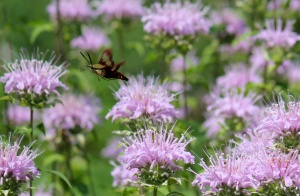

USDA-NRCS PLANTS Database / Britton, N.L., and A. Brown. 1913. An illustrated flora of the northern United States, Canada and the British Possessions. 3 vols. Charles Scribner’s Sons, New York. Vol. 3: 132.
WILD SEED PROJECT IS OFFERING SEEDS, SO THIS SPECIES IS NOT A PRIORITY.
Where Commonly Found: Forest, meadows, fields and gardens, CT, ME, MA, NH, NY, RI, VT.
How to Identify:
(For unfamiliar words: Wikipedia Glossary of Botanical Terms).
Go Botany Key to Monarda fistulosa,
Missouri Botanical Garden website for Monarda fistulosa.
Flower Type: Lavender purple long-blooming, rounded flowerheads, 1″-3″ across form at the top of major stems, opening first from center then to periphery, resulting in a wreath of flowers. Each corolla extends into an upper lip that is tubular with projecting stamen and 3 lower lips.
Flower Time: Mid-June to Mid-September
Leaf Arrangement: Opposite leaves on frequently branching light green, four-angled, hairless stems.
Leaf Type: Broadly lanceolate to ovate, with serrated margins, up to 4″ long and 2″ across, light green to dark green, hairless leaves, sometimes tinted yellow or red depending upon environmental conditions. Earl Grey tea drinkers will recognize that Bergamot aroma.
Seed Collection: Ovoid nutlets form approximately 2 -3 weeks after bloom. Test if ready by bending over the stem into a bag and tapping. If ready, brown seeds will release. Spread on paper to dry for 2 – 3 days, store cool and dry.
Attracts: Bees, Butterflies, Hummingbirds
Use: Garden, Naturalizing and Monarch Garden
Light: Full Sun to Part Sun
Hardiness Zone: 3 to 9 USDA Zone Map
Soils: Dry to Moist
Height: 2.5′ – 3′
Notes: Wild Bergamot is a long-lasting butterfly-ladened wildflower of very high pollinator value with plentiful flowers and aromatic foliage.
Native to all US except CA and FL, EXTINCT in RI: Biota of North American Program (BONAP) – North America Plant Atlas (NAPA).
You must be logged in to post a comment.